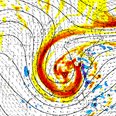-
Posts
5,750 -
Joined
-
Last visited
Content Type
Profiles
Blogs
Forums
American Weather
Media Demo
Store
Gallery
Everything posted by brooklynwx99
-
the Pacific jet retracts pretty handily by the end of the run. this would allow for more of a typical Aleutian LP and heights in AK would recover
-
you can see the jet retraction happening here. good to see models showing this, as it would lead to more of a typical Aleutian LP rather than a rogue super GoA low
-
it isn't getting kicked for some nebulous reason like it does for the truly shitty winters. there was a jet extension modeled that usually promotes a +PNA and sometimes a -EPO, but there was extratropical forcing that led to the jet becoming way too strong. luckily, that is a temporary factor, and the pattern likely becomes more favorable into early Jan as the jet inevitably retracts somewhat. it's like a delay of a week or so, most likely, and it's for a well defined reason
-
heights over AK should improve as the jet retracts, thus improving the source region the difference with the source region is night and day comparing the end of December and the start of Jan, verbatim anyway. you have cross polar flow in Jan showing up there
-
yeah I can see a touch AN especially into NE, but the torch should abate as we step into typical Nino climo
-
not making a direct pattern comparison to Feb 2010 by any means, just saying that Canada doesn't need to be frigid or even near normal for our intents and purposes. their averages are way colder than ours. that doesn't address the lack of cold air here, but it can be colder than average here and way warmer than average there and it works
-
this is my point about Canada. these were the 850mb temp anomalies in Feb 2010. Canada was absolutely roasting... some spots were like 15F above normal right in our SE Canada source region. like literally all of Canada is inundated with Pacific air and at least 5 degrees F above normal and it didn't matter
-
i can see us getting to near normal during the end of the first week of Jan. Central Canada can be +5 for all we care, that is cold enough in Jan
-
i don't expect the Pacific jet to remain this strong. there's going to be an anomalous +EAMT event that leads to the extension and heights in AK likely rise as the jet retracts
-
"punting to Jan" isn't really a good term for it. coastal SNE and south don't really do much in December. punting to Feb, on the other hand? that's an issue. don't expect that as of now, though
-
i would be shocked if Feb torched
-
Canada can also be pretty heavily AN and it wouldn't matter for our intents and purposes. +5 in central Canada in Jan is still frigid here
-
however, I would say that the first week of Jan is when the jet starts to retract and you get temps closer to normal for the MA... probably still AN from NYC north. trough develops in the SE and heights rise into AK to near normal. then in the second week, you can pop a -EPO and the risk for -NAO blocking increases. this is where the better chances probably crop up i don't really see any reason for why this pattern would continue. the jet is forced by an anomalous +EAMT event and it will retract. when it does, the more favorable window opens. models underdid the effect of the EAMT and subsequent jet extension
-
if you got an honest answer, it would probably be optimistic given that these winters start off shitty and get better as time goes on, and that inherent optimism would fall on deaf ears
-
can kinda see it here. would give more of a typical Aleutian LP response and +PNA/neutral EPO rather than a death star over AK
-
that +EAMT pushed it over the edge. jet extensions are good, but we got too much of a good thing. at least we'll have a window open up in early-mid Jan when the jet should retract
-
pattern changes up after Christmas, most likely
-
lol people were probably saying the same thing after Dec 2015 as well. wonder how that played out
-
yeah, same thing happened in January 2015. idk if anything of note happened that winter
-
there is just no cold air in the US. look at the heights
-
you wouldn't see snow in 1875 with an antecedent pattern like this in mid-December
-
not really, no. it's early and the pattern sucks in general
-
we are in a strong Nino that is doing a good job exerting itself, which is leading to a jet extension mid-month. there is nothing Niña about that at all
-
sorry, but this has been irking me. this is NOT a Niña-esque pattern! this is a textbook December Nino pattern… not every crappy pattern is the fault of a La Nina however, this pattern likely transforms to a more favorable one towards January, as we usually see
-
my issue with posts like these (not yours, the tweet itself) is that: 1) this is a strong El Niño December. they are warm almost invariably 2) WHO is calling for significant cold? like you’re preaching to the choir. not a soul on this earth thought it would be cold this month






